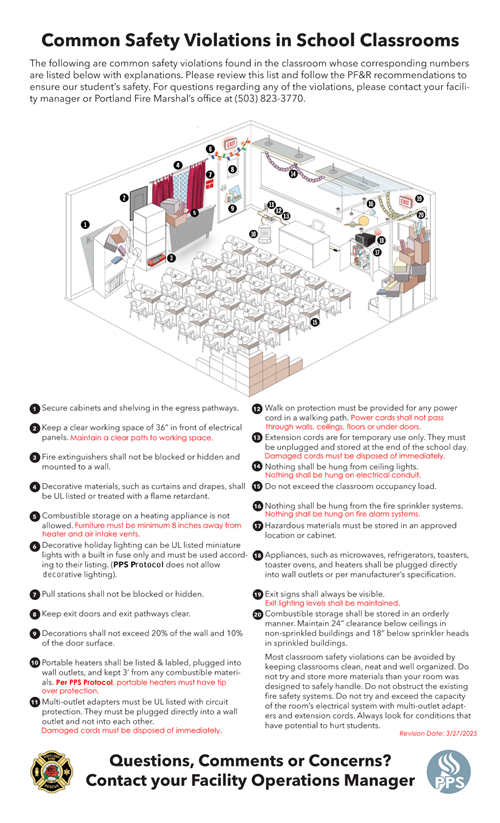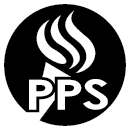-
Code Compliance
Code compliance for PPS sites ranges from Fire to Building, Electrical, and Mechanical codes, among others. Some of the most critical safety work in our schools is to maintain continual compliance with the Fire Code.
Maintaining Fire Code compliance is the responsibility of each site supervisor with the support of their Senior Facility Operations Manager and PPS Operations. The PPS Code Compliance Manager is the liaison who works directly with the Portland Fire Marshal and will be on site to observe site inspection activities with them.
This form from Portland Fire and Rescue shows the most common safety violations in classrooms. For easy reference, it is posted in every school.
MOVING OR CHANGING THE USE OF A CLASSROOM OR SPACE?
A permit from the City of Portland is required for approval to change the use of a room. Site administrators should contact Real Estate & Construction if they would like to request a change of space use. If a space use is changed without a permit, it may be reverted back to the original use in order to align with code requirements.
FIRE / EARTHQUAKE DRILLS:
All site administrators must maintain current fire and earthquake drill documentation in the red “Fire & Life Safety” book located in the office. Schools enrolled in the K-2 on the Second Floor Program must perform fire drills weekly through September.
CLASSROOMS & CORRIDORS:
Help keep PPS in compliance with the Fire Code by always doing the following:
- Classroom Seating: Arrange furniture in aisles to allow 30 inches for exit pathways in between desks/tables.
- Classroom Doors: Close classroom doors when the spaces are not occupied. Classroom doors may be open when the space is occupied to allow for improved ventilation. This can be done in two ways, 1) By using an electro-magnetic holder that is connected to the fire alarm system, or 2) by using a one gallon container filled with sand as approved by the Fire Marshal. Wood wedges, bricks, concrete blocks, or other heavy items used to block a door open are not allowed. Displays on doors are only allowed if they are done with removable materials and may not exceed 10% of the door surface area or block code required notices such as room numbers or evacuation maps.
- Recycling: Recycling is combustible so the volume allowed in each classroom is limited. A 15-gallon recycling container per classroom at the teacher’s desk is allowed. Empty contents regularly.
- Displays and artwork: Displays constructed of combustible material such as paper or fabric may not exceed 20% of any wall surface. Displays must be constructed of flame retardant material or treated with an approved fire retardant, which is available through the warehouse. Each school is required to maintain documentation that displays and artwork are flame retardant. Label roll paper dispenser “FIRE RETARDANT”. Save packaging labels. For applied fire retardant treatment, provide a test sample of display material that is 1 inch wide x 12 inch long with the date applied, name of applier, and labeled “FIRE RETARDANT TEST SAMPLE”.
- Displays near ceilings: Using light fixtures, fire sprinklers, ceiling tiles, or ceiling grids to support or hang displays is not allowed. Two wires per classroom are allowed for displays. The wires must be a minimum 84” from the floor when fully used.
- Electrical: The use of outlet adapters that increase outlet capacity is prohibited. The use of extension cords to provide a means of permanent power is prohibited. The use of extension cords as a means of providing temporary power to a device is acceptable. Temporary is not full-time use. Remove each extension cord when not in use (unplug and coil, do not leave on the floor). A device is defined as a portable piece of equipment such as an overhead or data projector. Holiday lights, such as Christmas tree lights, are prohibited. Plug strips purchased through the warehouse are acceptable means of providing, extending or increasing outlet capacity. Use of refrigerators and microwave ovens are strongly discouraged and can only be plugged directly into the wall outlet. Electrical panels must have 36” of unobstructed and free-and-clear area directly in front of the panel.
CORRIDORS & STAIRWELLS:
Do not locate combustible (paper and fabric) displays in stairwells. Maintain corridors and stairwells free-and-clear of objects that could obstruct emergency egress. Cross-corridor displays and banners are prohibited.
STOREROOMS:
Maintain 24-inch aisles throughout all storerooms. Maintain a minimum 24-inch clearance between the top of storage items and the ceiling. Maintain 24-inch clear pathway to fire-fighting equipment such as fire extinguishers and fire sprinkler valves and fire alarm panels. Stored items on the top shelves should not exceed 18-inches in height. Maintain at least an 18-inch clearance between the top of all stored items and overhead sprinklers.
BOILER ROOMS:
Boiler rooms are required to be maintained in a clean orderly fashion. Boiler rooms are not allowed to be used for any storage. Combustible materials such as paper and cardboard are strictly prohibited in boiler rooms. Flammable liquids must be stored in flammable liquid cabinets with doors closed and latched at all times. A clear area of 36 inches from electrical panels or equipment disconnects is required. Grease or oil-laden rags used for cleaning oil filters must be placed in an approved metal type 1 flammable material disposal container. Containers are red with self-closing lid. Call Herb Wagner ext. 74277 for disposal.
ELECTRICAL DISTRIBUTION, MDF AND HDF ROOMS:
Storage is not allowed in MDF and HDF rooms. No items may be placed within 36 inches of electrical panels or equipment disconnects.
ELECTRICAL SUB DISTRIBUTION PANELS: (Located in custodial closets, storerooms and corridors)
Clearance of 36 inches of electrical sub-distribution panels is required. Panels located in corridors and stairwells should be closed and locked at all times. Maintain a 24-inch clear pathway to fire-fighting equipment such as fire extinguishers and fire sprinkler valves. No storage shelving may be placed in front of fire-fighting equipment.
MECHANICAL ROOMS & FAN ROOMS:
Storage is not allowed in mechanical rooms, fan rooms, plenums or elevator equipment rooms. Clearance of 36 inches of equipment disconnects is required. Maintain 24-inch clear pathway to fire-fighting equipment such as fire extinguishers and fire sprinkler valves.
MISCELLANEOUS:
Fire extinguishers, fire hose cabinets and fire alarm pull stations are to remain unobstructed, with access free and clear at all times.
Select a School...
Select a School
- Abernethy Elementary School
- ACCESS Academy Alternative Program
- Ainsworth Elementary School
- Alameda Elementary School
- Alliance High School at Kenton
- Alliance High School
- Arleta K-5
- Astor K-8
- Atkinson Elementary School
- Beach School
- Beaumont Middle School
- Benson High School
- Beverly Cleary K-8
- Boise-Eliot/Humboldt Elementary School
- Bridger Creative Science School
- Bridlemile Elementary School
- Buckman Elementary School
- Capitol Hill Elementary School
- Chapman Elementary School
- Chief Joseph Elementary
- Clark K-5
- Cleveland High School
- College & Career Readiness
- Creston K-5
- Cesar Chavez School
- da Vinci Arts Middle School
- Dr. Martin Luther King Jr. Elementary School
- Duniway Elementary
- Faubion PK-8
- Forest Park Elementary School
- Franklin High School
- George Middle School
- Glencoe Elementary School
- Grant High School
- Grout Elementary School
- Harriet Tubman Middle School
- Harrison Park Middle School
- Hayhurst Elementary School
- Hosford Middle School
- Ida B. Wells High School
- Irvington Elementary School
- Jackson Middle School
- James John Elementary School
- Jason Lee Elementary School
- Jefferson High School
- Kellogg Middle School
- Kelly Elementary School
- Lane Middle School
- Laurelhurst K-8
- Lent K-5
- Lewis Elementary School
- Lincoln High School
- Llewellyn Elementary School
- Maplewood Elementary School
- Markham Elementary School
- Marysville K-5
- McDaniel High School
- Metropolitan Learning Center
- Mt. Tabor Middle School
- Future Now
- Media Center
- Bond
- Ockley Green Middle School
- Odyssey Program
- Peninsula K-5
- Pioneer Special School Program
- Portland Evening and Summer Scholars
- PREP
- Richmond Elementary School
- Rieke Elementary School
- Rigler Elementary School
- Robert Gray Middle School
- Roosevelt High School
- Rosa Parks Elementary School
- Rose City Park Elementary School
- Roseway Heights Middle School
- Sabin Elementary School
- Scott Elementary School
- Sellwood Middle School
- Sitton Elementary School
- Skyline K-8
- Stephenson Elementary School
- Sunnyside Environmental K-8
- Vernon K-8
- Vestal Elementary School
- West Sylvan Middle School
- Whitman Elementary School
- Winterhaven K-8
- Woodlawn K-5
- Woodmere Elementary School
- Woodstock Elementary School


